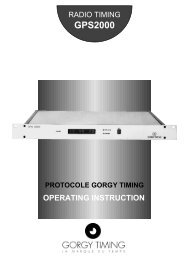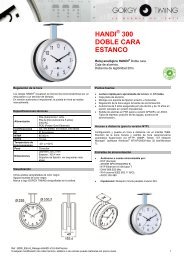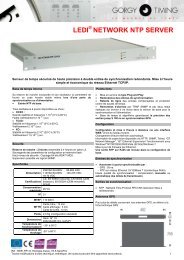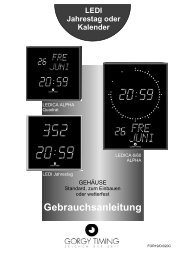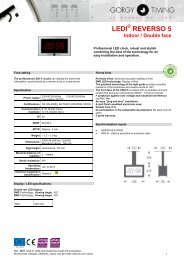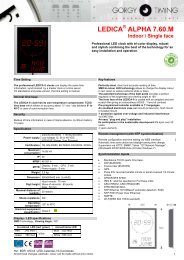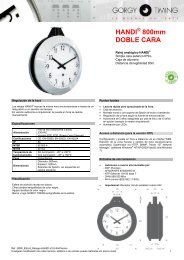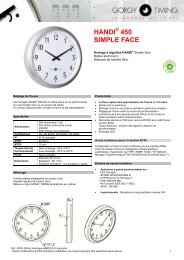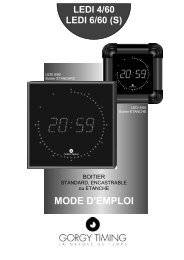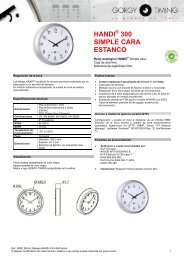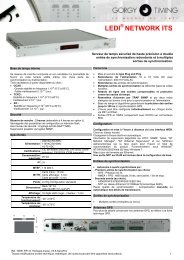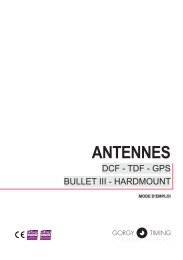Ledi 5 micro - Gorgy Timing
Ledi 5 micro - Gorgy Timing
Ledi 5 micro - Gorgy Timing
You also want an ePaper? Increase the reach of your titles
YUMPU automatically turns print PDFs into web optimized ePapers that Google loves.
LEDI green – LEDI 5Fig.1187Fig.211615323027375miniFig.2 bis11015375mini230Part to clean273Fig.3230VOffOn+-ProgSynchro.B12Use the lever tomake the connection.
LEDI green – LEDI 5I – INSTALLATIONWALL installation (fig.1)Fasten the ABS bracket onto the desired support, using two M4 screws.Fasten the clock case to the ABS bracket.(allow for a margin of at least 40 mm between the top of the case and the ceiling).FLUSH-MOUNTABLE installation (Fig.2)Provide an opening in the wall measuring 230 x 116 x 75 mm.Place the clock's "support-clip" in the wall opening.Clip the clock to its support.FLUSH-MOUNTABLE adhesive installation (Fig.2bis)Warning: The clock is supplied with two adhesive grips (20cm lenght). The adhesive grip have to beused on clean and smooth surface (do not valid for some plastics).Make an opening hole dimensions: 230x110x75mm (maxi. 235x115mm).Clean the support surface where the adhesive grip will be hang (the support must be free from dust,grease, silicon, humidity…)Installation: Take off the paper protection from the adhesive grip, place the clock in the opening holeand press firmly during 10-20 seconds.Testing the grip mounting support: Take off the clock from the wall, and be sure that the grip is still wellin place. If not, please re-fix the clock since the beginning and leave the grip without the clock during 24HOURS. After 24 hours, re-place the clock and again make the test. If the grip is coming again, you haveto use a clock mount support ref. 120012 (delivered on order request).II – START-UP (Fig.3)Plug the outgoing cable into the 230V 50-60Hz mains supply.For receiving or radio-synchro versions, connect the impulses, the AFNOR code or the antenna to the B1terminal (no polarity).Switch the battery main switch to the ON position (lower position) after connecting the clock.IMPORTANT: if the hour - minute portion of the clock remains off, wait a few minutes for the internalbattery to charge.SETTING THE TIME:- Time is set with the 3 buttons on the back.- A 1 st press on the "Prog" button makes the hour setting blink. Use the "+" and "-" buttons to increaseor decrease the displayed number.- Press a second time on the "Prog" button to validate your selection.Proceed in the same way for the minutes.AUTONOMOUS Version:Pressing on "Prog" will make the display blink to indicate that the clock is in the synchronisation mode.Pressing on "Prog" a second time makes it possible to synchronise the clock with a time cue given by atime reference (ex. the speaking clock).RECEIVING Version:When terminal B1 is connected, the clock automatically switches from the stand alone mode to thereceiving mode.Impulse receiving version: Set the time manually, the clock will increment itself with each impulse fromthe master clock .AFNOR NFS87500 version: the clock sets itself automatically.RADIO SYNCHRO version: (see antenna manual).III – TECHNICAL CHARACTERISTICSSupply 230VAC (+/- 10%)/50-60Hz, power 3.2VAStand alone version: accuracy 0.02 sec./24 hrs between 20°C and 30°CReceiving version: Code IRIG.B carrier 1Khz, rated input level: 2.2VDC,Input impedance: 3.5 kohms, galvanic insulation via transformer,Rated input voltage 70mVDC3
LEDI green – LEDI 5WARNINGDISCONNECTTHE MAINS SUPPLYBEFORE OPENING THE CASEGORGY TIMING RC 74 B 38 Registered trademark and pattern All modifications reserved - FOR19/A/002C4




